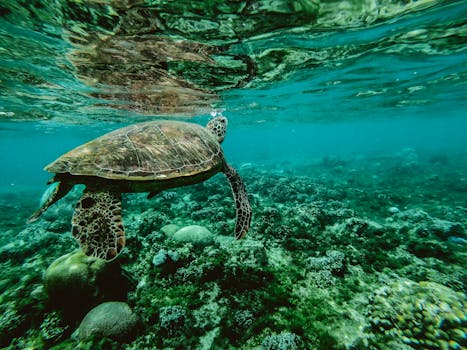Diving into the vibrant underwater world of Hawaii with an Insta360 camera reveals breathtaking 360-degree views. This adventure showcases the camera's capabilities and the stunning marine life, enhanced by recent software updates and new diving stats.

Exploring Hawaii's Depths in 360: An Insta360 Dive Adventure
Hawaii's turquoise waters beckoned, and I knew I had to capture their beauty in a unique way. Armed with my Insta360 camera and a waterproof housing, I embarked on an underwater adventure to explore the vibrant coral reefs and diverse marine life. The results? Absolutely breathtaking 360-degree views that immerse you in the heart of the ocean.
Preparing for the Plunge: Gear and Settings
Before diving in, careful preparation is key. Ensuring your Insta360 camera is properly housed and sealed is paramount. A leak could spell disaster! Additionally, understanding the camera's settings and how they perform underwater is crucial for capturing quality footage.
# Waterproof Housing and Sealing
Invest in a high-quality waterproof housing designed specifically for your Insta360 model. Double-check all seals and O-rings for any signs of wear or damage before each dive. Apply a thin layer of silicone grease to the O-rings to ensure a watertight seal. I also recommend doing a test in a shallow pool or bucket of water before venturing into deeper waters.
# Camera Settings for Underwater Filming
Underwater environments present unique challenges for cameras. Light diminishes rapidly with depth, and color casts can become prevalent. Here are some settings to consider:
- White Balance: Set a custom white balance based on the depth and water conditions. Many Insta360 cameras have a dedicated underwater white balance setting, which is a great starting point.
- ISO: Keep the ISO as low as possible to minimize noise. However, be prepared to increase it slightly in darker environments. Experiment to find the best balance between brightness and noise.
- Shutter Speed: A faster shutter speed helps to freeze motion and reduce blur, especially when dealing with moving subjects or choppy water. Start with 1/60th of a second and adjust as needed.
- Resolution and Frame Rate: I opted for 5.7K resolution at 30fps. This provided a good balance between image quality and file size. Higher frame rates (60fps or 120fps) can be useful for capturing slow-motion footage.
Immersing Myself in the Underwater World
Descending into the Hawaiian waters was like entering another world. Schools of colorful fish darted among the coral reefs, while sea turtles gracefully glided by. Capturing these moments in 360 degrees allowed me to share the full scope of the experience with others.
# Encountering Marine Life
The highlight of the dive was undoubtedly the encounters with marine life. I swam alongside playful dolphins, watched a moray eel peek out from its hiding place, and marveled at the intricate patterns of the coral formations. The Insta360 captured these encounters with stunning clarity, allowing viewers to feel like they were right there with me.
# Navigating the Underwater Environment
Filming in 360 degrees underwater requires careful navigation. Avoid sudden movements and try to maintain a steady position to prevent motion sickness for viewers. Be mindful of your surroundings and avoid disturbing the marine life. I found that using a dive scooter helped me cover more ground and maintain a stable camera position.
Post-Processing and Editing: Bringing the Footage to Life
Once back on dry land, the real work began: post-processing and editing the 360-degree footage. This involves stitching the images together, correcting color casts, and adding stabilization.
# Stitching and Stabilization
Insta360's software provides excellent tools for stitching and stabilizing 360-degree footage. The software automatically aligns the images from the camera's multiple lenses and removes any unwanted movement. Experiment with different stabilization settings to achieve the smoothest possible footage.
# Color Correction and Grading
Underwater footage often suffers from color casts due to the absorption of light by water. Use color correction tools to restore the natural colors of the scene. I found that adjusting the white balance and adding a touch of saturation helped to bring the footage to life. Consider using color grading techniques to enhance the overall look and feel of the video.
# Adding Narration and Music
Adding narration and music can further enhance the viewing experience. A well-crafted narration can provide context and insights into the underwater environment, while music can evoke emotions and create a more immersive atmosphere. Choose music that complements the visuals and enhances the overall mood of the video.
Conclusion: Sharing the Underwater Magic
Filming underwater in 360 degrees with an Insta360 camera is a truly remarkable experience. It allows you to capture the beauty and wonder of the underwater world in a way that traditional cameras simply cannot. With careful preparation, the right settings, and some post-processing magic, you can create stunning 360-degree videos that transport viewers to the heart of the ocean. The recent updates and new sports watch diving statistics from Insta360 further enhance the experience, giving you even more data and control over your underwater adventures. So, grab your Insta360 camera, dive in, and share the magic of the underwater world with the world!
